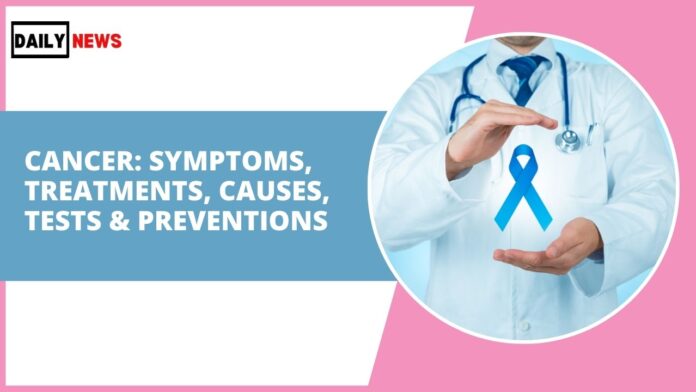Cancer is one of the most significant health challenges faced globally, impacting millions of lives each year. Understanding this complex condition can empower individuals with the knowledge to recognize early warning signs, seek timely treatment, and adopt measures to reduce their risk.
What is Cancer?
Cancer is a condition characterized by the abnormal and uncontrolled growth of cells in the body. These cells can invade surrounding tissues and spread to other parts of the body, a process known as metastasis. There are more than 100 types of cancer, each affecting different organs and tissues.
Common Symptoms of Cancer
While symptoms vary depending on the type and location of cancer, some general signs should never be ignored:
- Unexplained Weight Loss: A sudden loss of weight without dietary changes or exercise is often an early warning sign.
- Fatigue: Persistent and extreme tiredness that doesn’t improve with rest.
- Pain: Persistent pain in specific areas of the body, such as back pain or headaches, may indicate cancer.
- Skin Changes: Darkened patches, yellowish skin, or changes in moles can signal skin cancer or other types.
- Unusual Bleeding: Blood in the stool, urine, or coughing up blood can be signs of internal cancers.
- Lumps or Thickened Tissue: Detectable lumps, particularly in the breast, testicles, or lymph nodes, often warrant immediate medical evaluation.
- Chronic Cough or Hoarseness: Persistent respiratory symptoms may be associated with lung or throat cancer.
Early detection significantly improves the prognosis for most cancers.
Causes of Cancer
Cancer arises from genetic mutations that disrupt normal cell functions. These mutations may occur due to various factors, including:
1. Lifestyle Factors
- Smoking: Tobacco use is the leading preventable cause of cancer, particularly lung, mouth, and throat cancers.
- Diet: High-fat diets and low consumption of fruits and vegetables can increase cancer risk.
- Alcohol: Excessive alcohol consumption is linked to liver, esophageal, and breast cancers.
2. Environmental Factors
- Radiation Exposure: Ultraviolet (UV) radiation from the sun is a major cause of skin cancer.
- Chemical Carcinogens: Prolonged exposure to harmful substances like asbestos, benzene, and pesticides can trigger mutations.
3. Genetic Predisposition
Inherited genetic mutations, such as BRCA1 and BRCA2, are associated with increased risks of breast and ovarian cancer.
Types of Cancer
Cancers are broadly categorized based on the origin of the abnormal cells:
- Carcinomas: Originate in epithelial cells, affecting organs like the skin, lungs, and liver.
- Sarcomas: Develop in connective tissues, including muscles and bones.
- Leukemia: Affects blood-forming tissues, leading to abnormal white blood cells.
- Lymphomas: Begin in the immune system’s lymphatic cells.
- Melanomas: Specifically involve pigment-producing cells in the skin.
Diagnostic Tests for Cancer
Timely diagnosis is critical for effective treatment. Common diagnostic methods include:
1. Imaging Tests
- CT Scans and MRI: Provide detailed images of tumors and surrounding tissues.
- Ultrasound: Useful for detecting tumors in soft tissues.
- X-rays: Often used to identify abnormalities in bones and the chest.
2. Laboratory Tests
- Blood Tests: Detect markers indicating specific cancers, such as PSA for prostate cancer.
- Urine Tests: Help identify cancer-related biomarkers.
3. Biopsy
A biopsy involves the removal of tissue samples for microscopic examination to confirm the presence of cancer cells.
Cancer Treatments
Advancements in medical science have expanded the range of treatments available for cancer. The choice of treatment depends on the type, stage, and location of cancer:
1. Surgery
Surgery involves the physical removal of tumors. It is most effective when the cancer is localized and has not spread.
2. Chemotherapy
This treatment uses powerful drugs to destroy rapidly dividing cancer cells. While effective, it often causes side effects like nausea and hair loss.
3. Radiation Therapy
High-energy radiation is used to kill cancer cells or shrink tumors. It is often combined with other treatments for enhanced efficacy.
4. Immunotherapy
Immunotherapy boosts the body’s natural defenses to fight cancer. It includes treatments like checkpoint inhibitors and CAR-T cell therapy.
5. Targeted Therapy
This approach focuses on specific genetic changes in cancer cells, minimizing damage to healthy tissues.
6. Hormone Therapy
Hormone therapy is effective against cancers like breast and prostate cancer that are influenced by hormones.
7. Stem Cell Transplant
Stem cell transplants restore blood-forming cells damaged by cancer or its treatments, especially in leukemia and lymphoma cases.
Prevention Strategies
Preventing cancer involves adopting a healthy lifestyle and minimizing exposure to known risk factors. Here are some proven strategies:
1. Avoid Tobacco
Eliminating tobacco use significantly reduces the risk of lung, mouth, and throat cancers.
2. Eat a Balanced Diet
Incorporate plenty of fruits, vegetables, and whole grains while avoiding processed and red meats.
3. Exercise Regularly
Staying physically active helps maintain a healthy weight and lowers cancer risk.
4. Protect Your Skin
Use sunscreen with an SPF of at least 30 and avoid tanning beds to reduce the risk of skin cancer.
5. Get Vaccinated
Vaccines for hepatitis B and human papillomavirus (HPV) can prevent infections linked to liver and cervical cancers.
6. Regular Screenings
Routine screenings, such as mammograms, colonoscopies, and Pap smears, help detect cancers in their early stages.
Living with Cancer
A cancer diagnosis can be overwhelming, but support systems and advanced treatments have made survivorship more manageable. Many patients find strength through counseling, support groups, and personalized care plans.

Er. Rishav Raj (Btech Computer Science)
Dr. Rishav Raj (Bachelor of Ayurvedic medicine and Surgery)
I am a professional blogger since 12 years worked for different healthcare blog as well as health care advisor for different multinational companies as well as Software developer for different healthcare and technology based software.i am here to share you some informative blog regarding news , healthcare and technology







